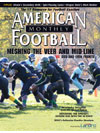AMERICAN FOOTBALL MONTHLY THE #1 RESOURCE FOR FOOTBALL COACHES
Article CategoriesAFM Magazine
|
Maximizing Your Time on the Practice FieldSan Diego State\'s defensive practice structureby: Curt Block © More from this issue Detailed preparation and expert organization are essential to every winning program. The practice schedules leading to Saturday must be precisely crafted, minute-to-minute plans designed to produce maximum effort at kickoff. AFM asked Defensive Coordinator Bob Elliott for a specific breakdown of how he gets his San Diego State Aztecs ready for Mountain West opponents. Most important for his players he said is to get them accustomed to the same routine every day. The details of the sessions may differ but the basics are the same: get to practice at 2pm. “We have a standardized plan that we use and then we fill in the template every day,” Elliott said. “We put everything we’re going to do each day on paper, which drills we’re going to do and at what time. The coaches carry this out to the field with them. I don....The full article can only be seen by subscribers. Subscribe today!
|
|
|||||||
| HOME |
MAGAZINE |
SUBSCRIBE | ONLINE COLUMNISTS | COACHING VIDEOS |
Copyright 2025, AmericanFootballMonthly.com
All Rights Reserved





